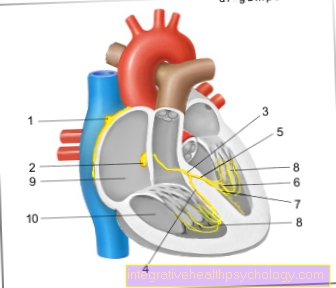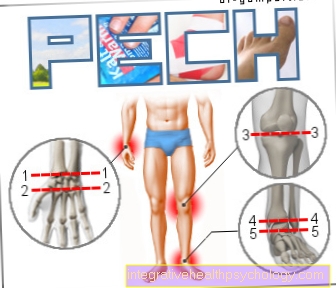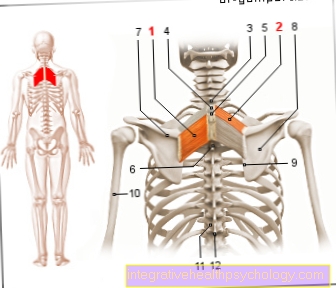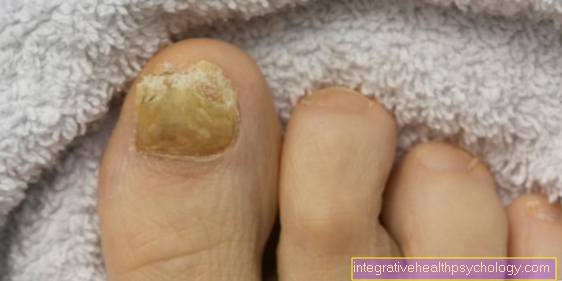Hyperextension
introduction
The most common form of back pain is in the lumbar spine area. A lack of exercise, incorrect posture, sedentary work and incorrect strain in sports lead to complaints in the lumbar spine. Since these muscles are hardly used in everyday movements, they are in most cases underdeveloped. One-sided loads in game sports such as Serves in tennis lead to muscular imbalances and also strain the lumbar spine. Alongside the deadlift, hyperextension is an ideal exercise for strengthening the lower back muscles. The deadlift is not suitable for fitness and health due to the high coordination requirements and the associated risks.
The broad back muscle (M. latissimus dorsi) cannot be trained with the exercise of hyperextension. The latissimus pull is suitable for the muscles in the upper back area.
Figure back muscles

Back muscles
- Trapezius -
Trapezius muscle - Deltoid -
Deltoid muscle - Small round muscle -
Teres minor muscle - Subbone Muscle -
Infraspinatus muscle - Large round muscle -
Teres major muscle - Broad back muscle -
Latissimus dorsi muscle - Back extensor (lower lying) -
Erector spinae muscle - Outer weird
Abdominal muscles -
M. obliquus externus abdominis - Belt muscle
(second layer) -
Muscle splenius - Scapula lifter
(second layer) -
Muscle levator scapulae - Small rhomboid muscle
(second layer) -
Rhomboideus minor muscle - Large rhomboid muscle
(second layer) -
Rhomboideus major muscle - Iliac crest -
Iliac crest - Gluteus Middle -
Gluteus medius muscle - Gluteus Muscle -
Gluteus maximus muscle
You can find an overview of all Dr-Gumpert images at: medical illustrations
Description hyperextension

The athlete lies on the device, the feet are fixed. In order to ensure a favorable working angle of the upper body, the hip closes with the device. In the starting position, the upper body and legs form a line. The hands are placed on the ear. The view is directed downwards. The upper body is held by the contraction of the lower back muscles and the hamstring muscles. In the yielding phase, the upper body is lowered until the upper body and legs form an approximately right angle. The tension in the muscles is maintained continuously. In the overcoming phase, the upper body is brought back to the starting position. The movement is slow.
To add to the strain, a weight is often held against the chest with the hands. However, it is not advisable to do so because of excessive loads.
Note: During the contraction phase, the upper body is not raised further than parallel to the floor. In most gyms, this can be checked very easily with a mirror.
As can be seen in the figure, the exercise can also be carried out in static form. The athlete lies flat on the floor and lifts arms and legs in a controlled manner.
Modifications
Various fitness devices modify the exercise of hyperextension, so the upper body and legs do not form a line on all machines, but a right angle between thighs and upper body. This makes movement easier and is therefore used particularly frequently in health training.
Another possibility of variation is to use an expander. You can find more detailed information on hyperextension with the expander here.


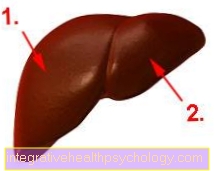
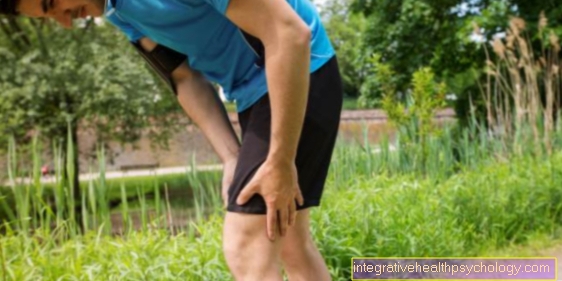



-mit-skoliose.jpg)






